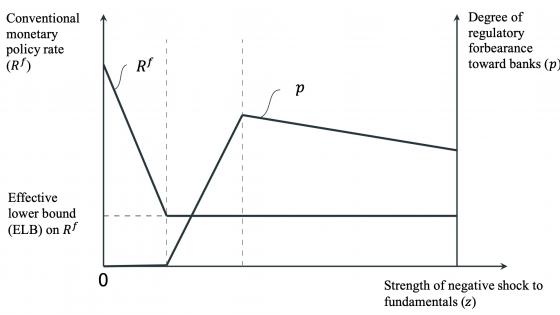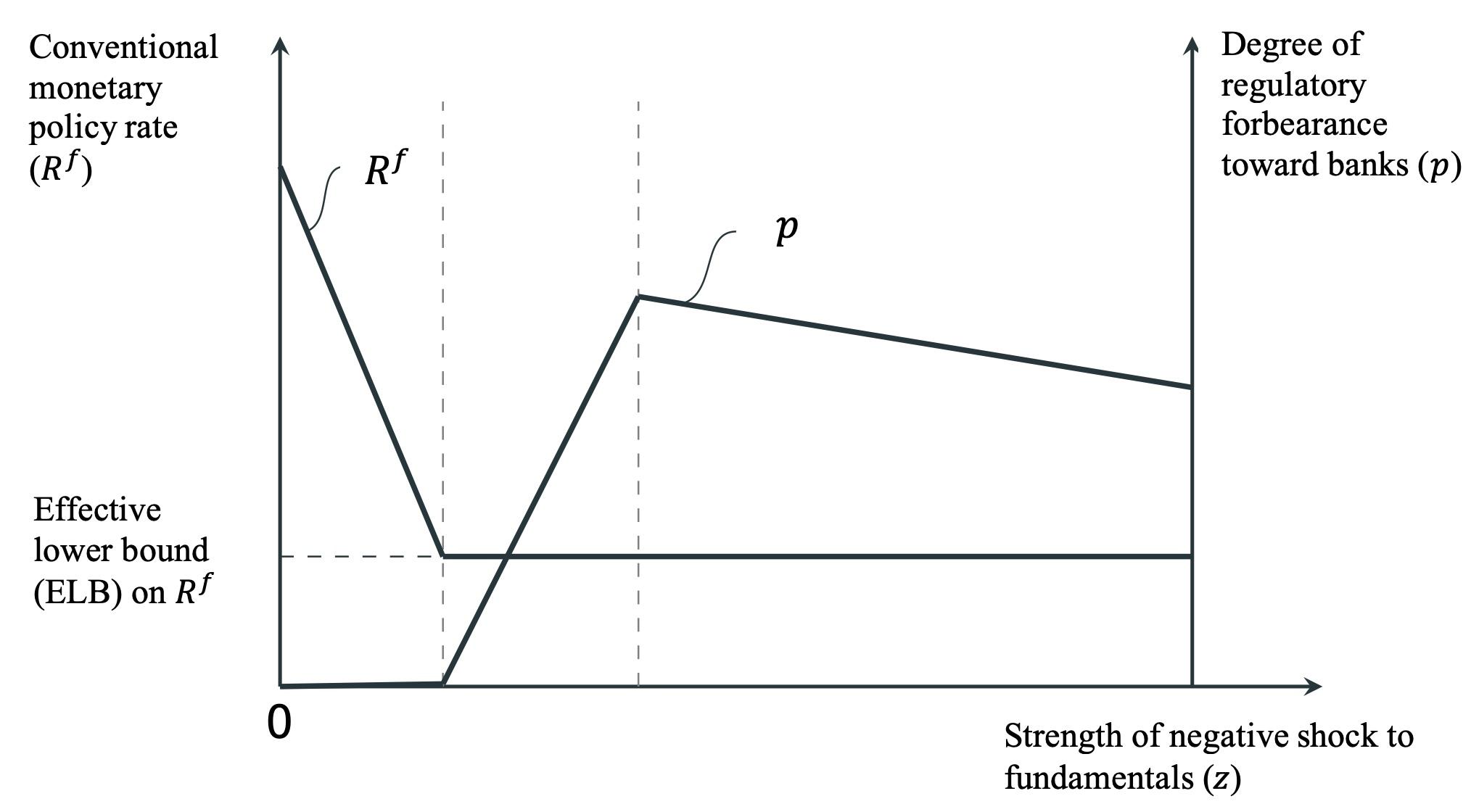Since the housing and banking crisis in Japan in the early 1990s, regulatory forbearance towards banks has been increasingly combined with accommodative monetary policy in a bid to restore economic growth. Such forbearance typically consists of explicit or implicit government guarantees to depositors and other creditors, as well as various forms of liquidity support from the central bank, while simultaneously allowing a delayed recognition of stressed or non-performing loans on bank balance-sheets. This combination of policies also found favour in the euro area periphery countries following the Global Crisis of 2007–08 and especially after the sovereign debt crisis in 2011–12. The operative period of this policy mix seemed to have become protracted relative to the initial intentions and expectations, while the impact on economic growth has remained muted. The global policy response to the COVID-19 pandemic has revived the debate regarding the efficacy of large-scale interventions aimed at stabilising the economy in response to large economic shocks. The combination of ultra-loose monetary policy and regulatory forbearance has raised the spectre of worldwide ‘zombification’ (Group of Thirty 2020, Laeven et al. 2020).
Starting with the seminal studies of Peek and Rosengren (2005) and Caballero et al. (2008) on the Japanese economy, a growing body of research attributes the ineffectiveness of policy in improving long-term economic outcomes to credit misallocation. In particular, weakly capitalised banks use regulatory forbearance to extend new credit or evergreen existing loans to their stressed borrowers, even as healthier firms in the economy experience adverse spillovers from the resulting proliferation of ‘zombie’ firms.
In a recent paper (Acharya et al. 2021), we review the empirical evidence on zombie lending and its real effects, and propose a theoretical framework consistent with this evidence to analyse how policy can affect the efficiency of credit allocation and long-term economic outcomes. A central contribution of our model is to highlight the role played by central bank and regulatory policies in shaping banks’ incentives, and thereby the equilibrium allocation of credit. We focus on the two most important components of policy for bank incentives: the interest rate set by conventional monetary policy; and ‘forbearance policy’, whose generosity captures a host of government guarantees and unconventional policy actions that subsidise bank lending.
Accommodative conventional monetary policy makes lending more attractive by lowering the return on other assets held by banks. This is a standard bank lending channel. Increasing forbearance also stimulates lending by reducing banks’ cost of funds. However, excessive forbearance can hurt the economy as it leads banks to engage in risk shifting. When a large share of credit risk is borne by the government, banks may tilt their lending towards riskier loans and less productive firms – this is the ‘zombie lending channel’.
Diabolical sorting
Our model shows how, in general equilibrium, regulatory forbearance can lead to zombie lending and to the ‘diabolical sorting’ documented by the literature, where low-capitalisation banks extend new credit or evergreen existing loans to low-productivity firms. Banks with low capital and high leverage end up lending to less productive firms, even though aggregate output would be raised by letting these firms exit and be replaced by more productive entrants. The key economic mechanism is that the implicit subsidy from government guarantees and forbearance is higher for banks with higher leverage and riskier assets.
This result highlights a delicate policy trade-off and opens the door for a meaningful normative analysis of credit misallocation. Specifically, while zombie lending and less creative destruction are the main perils on the side of poorly capitalised banks, policymakers must also encourage well-capitalised banks to lend. The latter are not tempted by zombie lending, but they may invest in safe assets instead of lending to good firms. This tension is at the heart of our analysis of the optimal policy mix in response to exogenous shocks.
Policy response to aggregate shocks
We analyse how policymakers should optimally combine their instruments to channel bank capital toward its most productive use and allow the economy to achieve its highest possible output. We argue that the optimal policy mix following an aggregate shock to fundamentals may feature a combination of conventional policy in the form of monetary accommodation and unconventional policy in the form of regulatory forbearance towards banks.
Figure 1 offers a graphical representation of this result. As long as the policy rate can be lowered without constraints, conventional monetary policy alone without any forbearance can stabilise output. Conventional monetary policy, however, may not be sufficient when shocks (whose size is given by z on the horizontal axis) are large because large shocks would call for an interest rate below the effective or zero lower bound. This is when unconventional policies may help stabilise output. Crafting the optimal level of forbearance, however, requires balancing the benefits from stimulus and the unintended consequences due to distortions. A small amount of forbearance is beneficial as it can substitute for the impaired conventional monetary policy and help lower banks’ funding costs, thereby stimulating lending and output.
Pulling too hard on the forbearance string, however, will spur zombie lending by weak banks and hurt aggregate output. Surprisingly, we show that larger economic shocks do not always call for more forbearance. When shocks are moderate, forbearance should increase with the size of the shock as expected. But in the face of large shocks, policymakers should actually backtrack and reduce forbearance to avoid a harmful composition of lending, even though this entails accepting a lower level of aggregate lending to the real economy. In this sense, our model predicts a ‘reversal’ level of unconventional monetary policy, thus complementing the concerns about the ‘reversal rate’ for conventional monetary policy.
Figure 1 Optimal policy response to a fundamental shock z
Policy traps and sclerosis
Zombie lending is far from a temporary problem. In fact, it has been proposed as one of the leading channels behind the Japanese stagnation taking place since the 1990s and the slow European recovery following the financial and sovereign debt crises (Hoshi and Kashyap 2015). To incorporate these features, we turn to a dynamic version of our model that emphasises how the interplay of accommodative policies and zombie lending can lead to persistent output losses and policy traps. The central determinant of the dynamics of zombie lending and policies is the strength of the spillovers of zombie lending on healthy firms. We compare long-term macroeconomic outcomes following a transitory aggregate shock under two polar policy regimes that differ in horizon of policymakers: ‘patient’ policymakers seeking to avoid future output losses; and ‘myopic’ policymakers willing to preserve incumbent firms at the expense of future productivity, either due to term limits or reputational concerns that shorten their effective horizon.
The salient insight from this analysis is that although the ‘myopic policy’ minimises short-run output losses through aggressive accommodation, this comes at the cost of slow recoveries or even permanently lower productivity and output, which we call ‘sclerosis’. Monetary accommodation and high forbearance aimed at stimulating the economy in response to large economic shocks can precipitate the economy into a ‘policy trap’: future policymakers inherit an economy with widespread zombie lending, lower productivity for all firms, and have no choice but to keep interest rates low and forbearance high if they also want to preserve short-run output.
Figure 2 shows the paths of output and policies depending on the policy regime. Following a small shock (top panel), the myopic policy response in red allows to smooth the impact of the shock at the cost of some modest endogenous persistence. Following a large shock (bottom panel), the impact effect is also milder under the myopic policy, but the economy falls into permanent sclerosis.
Figure 2 Output and policies following a transitory shock, as a function of time (t)
Viewed through the lens of our model, it thus becomes paramount for efficient policy to avoid economic sclerosis precisely when shocks are large, as addressing such shocks with aggressive regulatory forbearance in pursuit of secure short-term gains runs a high risk of zombie lending. Conversely, it may be necessary to embrace short-term V-shaped recessions when shocks are large to prevent a delayed recovery and potentially permanent output losses.
The role of bank capital
The distribution of bank capital is central to our analysis of zombie lending and optimal policy. Taking the capitalisation of the banking as given, the presence of undercapitalised banks constrains policymakers, thereby making the economy more susceptible to fundamental shocks. How do the conclusions reached so far change when banks can choose their capital structure? And if capital is endogenous, can regulators solve the misallocation of credit by forcing banks to raise more capital?
When frictions make equity issuances costly for banks, our analysis suggests that, on their own, poorly capitalised banks have insufficient incentives to increase their capital to escape the zombie lending region, because the equity issuance and payout decisions suffer from the same risk-shifting incentives as the lending decision. In fact, we find that accommodative monetary policy can worsen the zombie lending problem by reducing banks’ equity issuance, or equivalently, increasing bank payouts.
We reach subtle conclusions regarding capital requirements. They may be effective at mitigating zombie lending in some circumstances, but may backfire in others. While it may be socially efficient for a bank to terminate a relationship with a legacy borrower turned bad, the bank must bear a variety of private switching costs (e.g. loss provisions, costly restructuring or liquidation processes, or screening costs of new borrowers). If these switching costs are low enough, regulators can set high enough capital requirements to deter zombie lending altogether. If switching costs are high, however, capital requirements can backfire as a high level of required capital induces poorly capitalised institutions to evergreen, extending even more credit to their outstanding risky, unproductive borrowers, because recognising losses would force them to recapitalise at a cost. Thus, the timing of shifts in capital regulation becomes paramount. Maintaining a well-capitalised banking sector preventively in good times lowers the risk of zombie lending during bad times, while tough regulation may backfire if it comes once banks have already started lending to zombies.
References
Acharya, V V, S Lenzu and O Wang (2021), “Zombie Lending and Policy Traps”, working paper.
Caballero, R J, T Hoshi and A K Kashyap (2008), “Zombie lending and depressed restructuring in Japan”, American Economic Review 98: 1943–77.
Group of Thirty (2020), “Reviving and Restructuring the Corporate Sector Post-Covid: Designing Public Policy Interventions”, Working Group on Corporate Sector Revitalization.
Hoshi, T and A K Kashyap (2015), “Will the US and Europe avoid a lost decade? Lessons from Japan’s postcrisis experience”, IMF Economic Review 63: 110–163.
Laeven, L, G Schepens and I Schnabel (2020), “Zombification in Europe in times of pandemic”, VoxEU.org, 11 October.
Peek, J and E S Rosengren (2005), “Unnatural selection: Perverse incentives and the misallocation of credit in Japan”, American Economic Review 95: 1144–1166.







